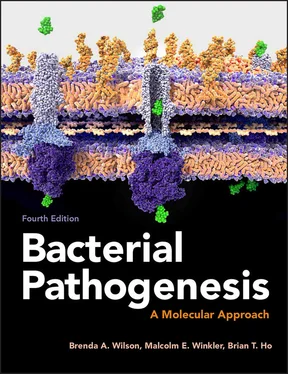7. Do you think humans will ever win the battle against disease-causing bacteria? Why or why not? Is the use of warlike language to describe the relationship between humans and bacteria even accurate?
8. Microbiologists are fond of saying that only a tiny minority of bacteria causes disease. Are there reasons for thinking this might not be true?
9. In what sense are bacteria life-givers rather than life-takers? Is it possible that disease-causing bacteria might have a beneficial role in another context or even in their relationship with the human body?
10. There are many diseases that manifest in a variety of ways in different, apparently healthy individuals (e.g., a bacterium may cause a mild fever and malaise in one person, while causing life-threatening disease in another). What are some of the factors that may contribute to this phenomenon?
2
IN THIS CHAPTER
The Best Defense: Avoid, Reduce, and Prevent Exposure!
Barriers: Skin and Mucosal Membranes
The Layers of Cells That Protect the Body
Normal Microbiota of the Skin and Mucosa
Defenses of the Skin
Defenses of Mucosal Surfaces
Special Defenses of the Gastrointestinal Tract
Special Defenses of the Urogenital Tract
Special Defenses of the Respiratory Tract
Immune Defenses of the Skin and Mucosa
Models for Studying Breaches of Barrier Defenses
Selected Readings
Questions
CHAPTER 2
Skin and Mucosa
THE FIRST LINES OF DEFENSE AGAINST BACTERIAL INFECTIONS
During medieval times, castles were built to serve not only as a residence for the feudal lord and his family and subjects, but also as a fortress to keep marauding enemies out. The most effective castles were designed by medieval engineers to last a long time, with high stone walls to withstand the onslaught of an enemy attack or prolonged siege. They were built in strategic locations surrounded by challenging terrain, such as on high ground with impassable moats or on top of steep cliffs. They were also poorly accessible, often with at least one side facing a waterfront, such as a river, lake, or ocean. Roads leading to the castle were usually twining and inclined to restrict access by wagons and hinder passage of large invading armies. Vigilant soldiers standing at the gates and archers placed along the top of the walls and in lookout towers guarded the castle against any would-be invaders that did approach the castle walls. And, if these barriers were still breached, the knights would mount fierce battles to protect the castle’s inhabitants. Like these medieval castles, our bodies are built as nearly impregnable fortresses, with analogous defensive strategies that protect the body against siege and invasion by potential microbial adversaries. Clearly, an attacking army required considerable ingenuity to breach the castle’s defenses. And, like the more successful medieval invader, the more successful invading bacteria (i.e., pathogens) have evolved clever virulence strategies to overcome those defenses of the body.
The Best Defense: Avoid, Reduce, and Prevent Exposure!
How is it possible that researchers and health care workers, who on a daily basis work with or are exposed to highly pathogenic microorganisms, do not get sick that often? This is because they have learned that the best line of defense is preventing exposure to a pathogen in the first place. In a research or health care setting, this can be achieved by avoiding direct contact through the use of gloves, protective clothing, and eyewear; disinfection of instruments and surface areas; and proper ventilation facilities. In the event that exposure does occur, other effective strategies come into play for preventing the pathogen from gaining entry into the body and establishing an infection. Of course, it helps to know the identity and properties of the pathogen that can be targeted for specific neutralization and also to bear in mind that any potential pathogen must always be treated with the utmost respect.
Reducing the number of bacteria that the body comes into contact with is a highly effective strategy to limit the risk of colonization and infection. There are many agents, natural (e.g., antibiotics, alcohols, and natural acids such as vinegar or citrus juice) or artificial (e.g., organic chemicals, drugs, and detergents), that can be used to kill or slow down the growth of microbes. Some of these agents can only be used externally on inanimate objects (e.g., disinfectants, sanitizers) or body surfaces (e.g., antiseptics, germicides) due to their harsh or toxic properties, but others are safe to ingest or inject in appropriate amounts (e.g., antibiotics, other antimicrobials). Personal hygiene through the use of handwashing with soap and water, as well as application of alcohol-based antiseptic gels, can also achieve the purpose of limiting exposure risks. We will revisit this topic later in chapter 15, when we discuss antimicrobial compounds.
Unfortunately, even with extra precautions and containment measures to reduce contact, accidental exposure can still occur through ingestion, inhalation, or direct contact with mucosal surfaces, such as the eyes or nose or through injury with sharp objects, needles, or abrasives. When this happens, it is comforting to know that the body has a number of impressive defense strategies already in place that make establishing an infection extremely difficult for the pathogen. The first of these strategies is a nearly impregnable physical and biochemical barrier that divides the external environment from the interior of the body. The second is the body’s ability to mount a massive counteroffensive against any invading microbe through the ever-vigilant immune system. This chapter and the ones that follow are intended to provide an overview of the defenses of the human body that limit colonization and prevent infection. We will begin the discussion of these host defenses in this chapter with the physical and biochemical surface barriers and will continue in chapters 3and 4with discussion of the internal defenses and protection provided by the immune system. Finally, as covered later in chapter 17, “Vaccination: an Underappreciated Component of the Modern Medical Armamentarium,” we will discuss how it is possible to further bolster this amazing defense system through vaccination and other therapeutic strategies.
Barriers: Skin and Mucosal Membranes
The skin and mucosal membranes of the human body are not simply inert physical barriers that keep good things in and bad things out. They comprise the body’s largest organ, which has a complex array of activities and functions that are only now beginning to be fully appreciated. As humans and other life-forms evolved, they were forced to contend in a bacteria-dominated world in which bacteria tended to view them as a free lunch. Survival meant developing defenses to keep these bacteria at bay. As such, these fortress-like defenses are extremely effective against bacterial incursions, preventing most bacteria from entering human tissues and the bloodstream and instead relegating them to the surface of the skin or confining them to certain closely guarded mucosal areas of the human body, such as the oronasopharyngeal (mouth, nose, and pharynx/throat), gastrointestinal, and urogenital tracts. Fortunately for us, only a tiny minority of bacteria is able to bypass these defenses and cause disease. To understand the mechanisms by which pathogenic bacteria cause disease, it is first essential to know what obstacles those few bacteria that do cause disease must overcome.
The Layers of Cells That Protect the Body
Epithelia are the layers of cells covering all of the external and internal surfaces of the body that are exposed to the external environment. These epithelial cell layers are an important initial defense against potential pathogens. The epithelial cells found in different body sites differ considerably in their properties, but they have some features in common.
Читать дальше












